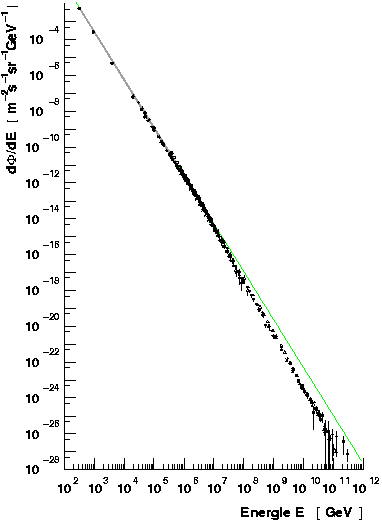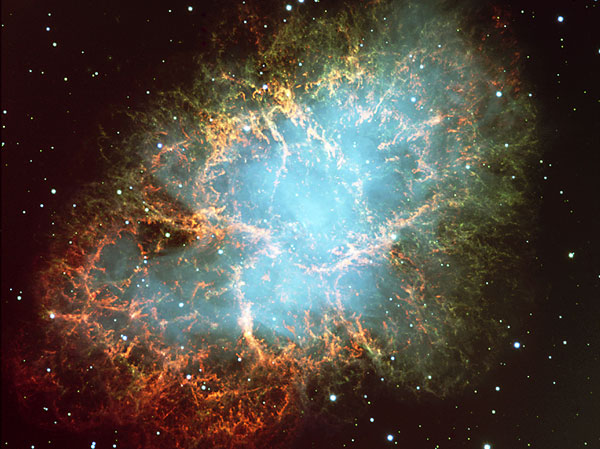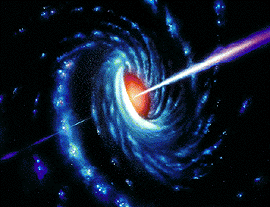H·E·S·S· physics
 The primary goal of the H·E·S·S· experiment
is to find the sources of high-energy particles of the Cosmic Radiation
which fills out the universe. The particle energies of the Cosmic Radiation
reach values up to 1020 eV and more. Energies of these
high values are not reachable by processes in thermal equilibrium. Furthermore,
the spectral shape (see right picture for the differencial spectrum) of
the Cosmic Radiation is not of the form processes of thermal equilibrium
would evoke. Therefore, it is often spoken of the non-thermal universe
in connection with the Cosmic Radiation. The non-thermal acceleration processes
collectively accumulate a huge amount of energy in a relatively small amount
of particles.
The primary goal of the H·E·S·S· experiment
is to find the sources of high-energy particles of the Cosmic Radiation
which fills out the universe. The particle energies of the Cosmic Radiation
reach values up to 1020 eV and more. Energies of these
high values are not reachable by processes in thermal equilibrium. Furthermore,
the spectral shape (see right picture for the differencial spectrum) of
the Cosmic Radiation is not of the form processes of thermal equilibrium
would evoke. Therefore, it is often spoken of the non-thermal universe
in connection with the Cosmic Radiation. The non-thermal acceleration processes
collectively accumulate a huge amount of energy in a relatively small amount
of particles.
Up to now, not many sources of the Cosmic Radiation
are known. At the same time many theories exist dealing with the acceleration
of high energy particles. One mechanism for acceleration of charged
particles up to extreme high energies is the so called shock front
acceleration: The magnetic field lines in the plasma of a shock front,
which emerges when flows of matter (i.e. strong stellar winds or Super
Nova Remnants (SNR)) hit interstellar clouds, concentrate. Charged particles
are cought by this strong magnetic field in the shock front. Since the
magnetic field concentrates, the mean energy of a charged particle incereases
until it leaves the shock front.
Since the spectrum of the Cosmic Radiation covers
many orders of magniditude in energy, different types of experiments
are used to detect the particles in the different energy intervals.
The ultra high energy (UHE) particles are detected by ground based detector arrays or experiments watching the fluorescence light (i.e. AUGER) emitted in the atmosphere by high energy components of air showers. Primary particles of energies in the GeV/TeV range are observed with ground based Cherenkov telescope experiments, whereas HEGRA and H·E·S·S· are some of them. Particles with energies below about 30 GeV are detected by satellite experiments . The observational energy gap between 30 GeV and abround 500 GeV will partly be closed by the H·E·S·S· telescope system since its energy threshold will be around 100 GeV. In the left picture an estimated flux sensitivity for the Crab nebula is shown.
The ultra high energy (UHE) particles are detected by ground based detector arrays or experiments watching the fluorescence light (i.e. AUGER) emitted in the atmosphere by high energy components of air showers. Primary particles of energies in the GeV/TeV range are observed with ground based Cherenkov telescope experiments, whereas HEGRA and H·E·S·S· are some of them. Particles with energies below about 30 GeV are detected by satellite experiments . The observational energy gap between 30 GeV and abround 500 GeV will partly be closed by the H·E·S·S· telescope system since its energy threshold will be around 100 GeV. In the left picture an estimated flux sensitivity for the Crab nebula is shown.
For locating the source of a high energy particle
(measured on earth) it is necessary to follow up the track of the corresponding
particle. In the case of charged particles which are deviated
by the galactic and intergalactic magnetic fields this is not possible
except for those with very high energies and relatively low distances (GZK-cutoff).
High energy photons (as well as neutrons and neutrinos) do not
loose their direction information even when putting back a huge distance.
Thus, they are suited to gain perceptions about the accelerators of (charged)
high energy particles: Often, a source of charged high energy particles
is also a source of high energy photons which emerge out of proton proton
collisions and the following pion decay or Synchrotron radiation
/ Bremsstrahlung of high energy electrons in strong magnetic fields
or the inverse Comton effect where a huge amount of the electron
energy is transfered to a photon.
The stereoscopic observation of air showers with
the H·E·S·S· telescopes allows a very effective
gamma-hadron separation, so one is able to do physics only with
photon induced air showers which in turn allow conclusions of their cosmic
origin. Single Cherenkov telescopes or systems of Cherenkov telescopes (i.e.
H·E·S·S·) use the Cherenkov effect described
in one of the following sections to record images of the corresponding air
shower.
 Even though the Cosmic Radiation was dicovered by Victor Hess
in the year 1912, not many of its sources are yet known. Since not many
objects are yet identified it is still not clear whether they are representatives
of their object class or just single exemplars. Many other, not yet observed
object classes are possible sources of high energy particle acceleration.
Even though the Cosmic Radiation was dicovered by Victor Hess
in the year 1912, not many of its sources are yet known. Since not many
objects are yet identified it is still not clear whether they are representatives
of their object class or just single exemplars. Many other, not yet observed
object classes are possible sources of high energy particle acceleration. One possible and already confirmed class of objects
are supernova remnants (SNRs). The expanding shell of the remnant
interacts with the interstellar medium under emerging of shock fronts.
Cas A is the most promiment example of a shell type SNR.
Pulsars and pulsar nebulae are also a possible
population of sources of TeV gamma photons. The pulsar accelerates particles
to high energies. The so emerging pulsar winds interact with the matter
of the sourrounding nebula or the interstellar medium which leads also
to the formation of shock fronts. The Crab nebula is such an object which
is already confirmed to be a steady TeV-gamma source (see right picture
for an optical image). The high energy gamma photons mainly emerge via inverse
Compton scattering of the Synchrotron radiation of electrons in the strong
magnetic field of the pulsar (Synchrotron Self Compton model).
Other possible but not yet confirmed objects in our
galaxy are accreting X-ray binaries, microquasars and
young open star clusters.
 Extracalactic sources of TeV-gamma photons are Active Galactic
Nuclei (AGN). If the plasma jet of an AGN is pointing to the observer
(Blazar, see the left picture for an artistic visualisation), the emission
of TeV-gamma photons may be observeable. Three objects of different cosmic
distances of this class are already confirmed and show strong flux variabilities
in the TeV-regime: Mkn-421, Mkn-501 and 1ES1426.
Extracalactic sources of TeV-gamma photons are Active Galactic
Nuclei (AGN). If the plasma jet of an AGN is pointing to the observer
(Blazar, see the left picture for an artistic visualisation), the emission
of TeV-gamma photons may be observeable. Three objects of different cosmic
distances of this class are already confirmed and show strong flux variabilities
in the TeV-regime: Mkn-421, Mkn-501 and 1ES1426. Other possible and not yet confirmed extragalactic
sources of TeV-gamma photons are starburst galaxies and clusters
of galaxies.
The flux sensitivity for the Crab nebula of
the H·E·S·S· telescopes is shown in the upper
plot. The first peak corresponds to the Synchrotron radiation and the
second to the inverse Comtpton scattering.
last modified: Mar 26th, 2002 by
and
